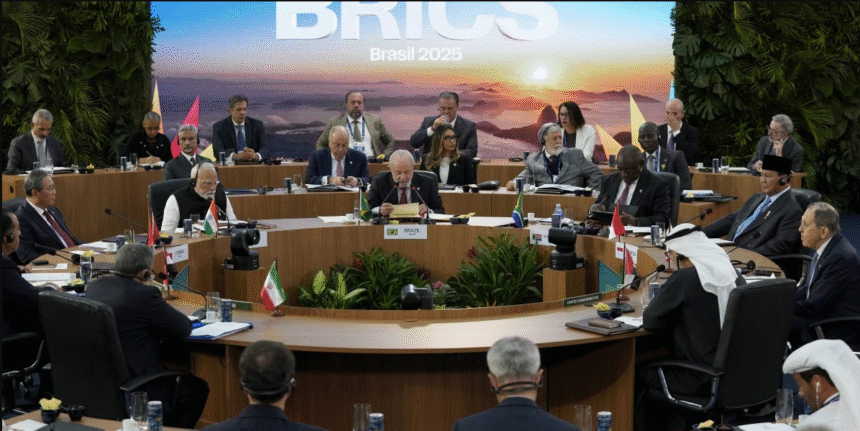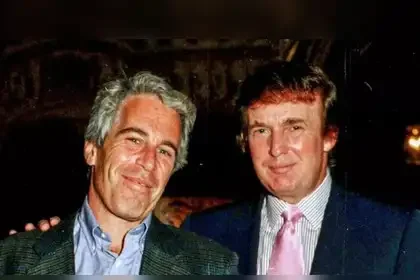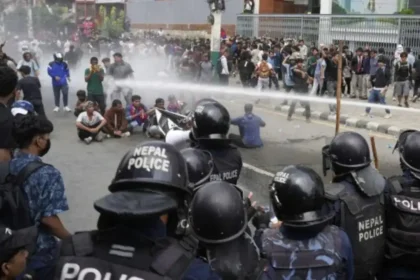Gaza Attacks, Iran Conflict and Tariff Wars Dominate BRICS 2025 Rio Summit
Gaza attacks, Iran conflict, and global tariff wars dominated the BRICS 2025 Rio Summit as leaders called for de-escalation and stronger multipolar diplomacy.
BRICS 2025 – A Turning Point in Multipolar Diplomacy?
The 17th annual BRICS Summit, hosted in Rio de Janeiro, Brazil, arrived amid extraordinary global turbulence: rising geopolitical flashpoints, surging unilateralism in global trade, and an intensifying East-West divide. But this year’s summit will likely be remembered not just for its expansion to 11 member countries but for what happened after: a dramatic tariff warning from US President Donald Trump, branding BRICS as an “anti-American alliance” and threatening all countries aligning with it with additional 10% duties.
“Any country aligning themselves with the Anti-American policies of BRICS will be charged an ADDITIONAL 10% Tariff. There will be no exceptions to this policy,” Trump declared in a stark post from the White House on July 5 via his platform, Truth Social.
That single line from Trump overshadowed what was already a high-stakes gathering of some of the world’s most consequential emerging powers. As BRICS nations — now comprising Brazil, Russia, India, China, South Africa, Indonesia, Egypt, Ethiopia, Iran, and the UAE — attempted to forge unity across topics like Gaza, Iran, global trade, and UNSC reform, Washington’s sudden escalation brought into focus the bloc’s deeper existential challenge: How far can it push multipolarity without inviting economic retaliation from the West?
This article, presented in multi-part format, explores the full dimensions of that question — from policy statements and leaders’ declarations, to diplomatic subtext, summit absences, intra-bloc disagreements, and American counterpunches. It reveals how BRICS finds itself at the center of one of the most high-stakes geopolitical recalibrations since the Cold War.
🔹 A Divided Summit: Power, Presence, and Posturing
Although the BRICS grouping has expanded, the summit in Rio de Janeiro was marked by notable absences. Russian President Vladimir Putin, facing an active International Criminal Court warrant, stayed away. Chinese President Xi Jinping, in a rare move, also skipped the summit — the first time since he took office in 2013.
Leaders who did attend included:
- Indian Prime Minister Narendra Modi,
- Indonesian President Prabowo Subianto,
- South African President Cyril Ramaphosa,
- Ethiopian Prime Minister Abiy Ahmed,
- Host Brazilian President Luiz Inácio Lula da Silva.
Though the 2025 summit was projected as a consolidation of multipolar leadership, the uneven participation exposed growing internal divergences within BRICS — particularly over the pace of dollar de-dollarization, collective economic policies, and responses to regional conflicts like Gaza, Ukraine, and Iran-Israel tensions.
🔹 Trump’s Tariff Ultimatum: A Direct Strike Against BRICS Unity
The BRICS declaration may have diplomatically avoided directly naming the United States, but Washington responded as though it had been. Trump’s follow-up message hours after the final communique was unequivocal:
“Anti-Americanism has a cost. Starting July 9, there will be an additional 10% tariff on any country that publicly aligns with BRICS anti-dollar or anti-NATO initiatives.”
This came just weeks after he had already threatened reciprocal tariffs of:
- 26% on India,
- 30% on South Africa,
- 84% on China,
as part of a broader protectionist drive.
Though these were temporarily suspended under a 90-day negotiation window, Trump’s July 5 statement makes clear that Washington’s patience with BRICS-led alternatives to the dollar is wearing thin. The threat represents a recalibrated economic doctrine — one that sees BRICS not just as a rival economic forum, but as a political alliance undermining American global leadership.
🔹 BRICS’ Response to Gaza: Strong Language, Diplomatic Limitations
Among the most anticipated parts of the Rio declaration was BRICS’ stance on the Israel-Gaza war, which has led to nearly 40,000 Palestinian deaths since 2024.
While the joint statement stopped short of using the term “genocide,” it “denounced Israeli attacks against humanitarian operations, facilities, personnel and distribution points”, and called for:
- Immediate ceasefire,
- Full Israeli military withdrawal from Gaza,
- Release of all hostages,
- Unrestricted humanitarian aid access.
The language echoed that of a recent UN General Assembly resolution, but interestingly, India had abstained from that vote, drawing domestic criticism.
During the summit, however, Indian PM Narendra Modi struck a different tone, delivering an address during the Peace and Security session that emphasized the universality of human rights:
“If our response depends on where or against whom the attack occurred, it shall be a betrayal of humanity itself.”
This marked a rhetorical shift, if not a diplomatic one, in India’s stance on the Gaza crisis. Observers say India’s participation in the Gaza language was carefully negotiated — supportive of humanitarian principles, but without overt alignment against Israel.
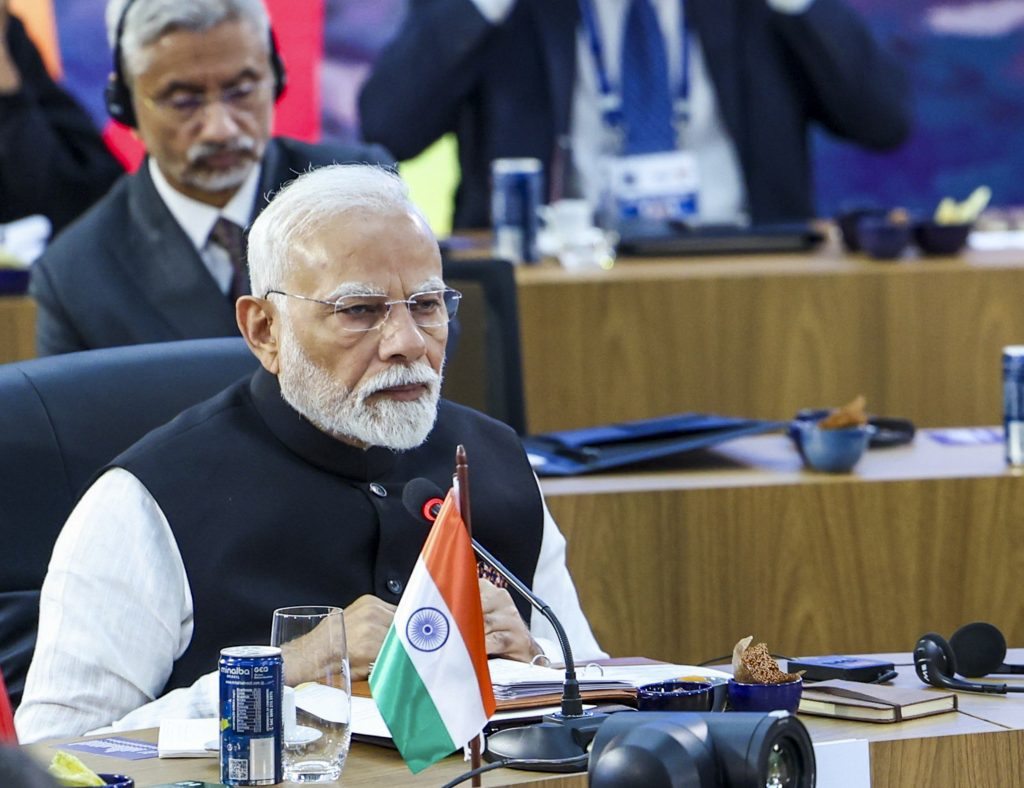
🔹 Iran-Israel Escalation: BRICS Tightens Language, Avoids Provocations
On the escalating military tensions between Iran and Israel, the BRICS declaration included language that condemned attacks on Iranian civilian and nuclear infrastructure, calling them violations of international law and IAEA regulations.
This marked a notable escalation in diplomatic language from the bloc’s earlier statement on June 25, which had merely expressed “grave concern”.
However, the declaration:
- Did not name Israel or the United States,
- Refrained from references to nuclear retaliation or Iranian countermeasures,
- Did not reference Iran’s April 2025 retaliatory drone attack near Tel Aviv.
That said, Iranian Foreign Minister Abbas Araghchi posted later on Telegram that Iran “reserves the right to self-defense under Article 51 of the UN Charter”, and warned BRICS not to “weaken its collective voice through vague diplomacy”.
🔹 India’s Two Priorities: Terrorism & UNSC Reform
For India, the real win at BRICS 2025 wasn’t on Gaza or Iran, but on two long-standing diplomatic battles:
1. Terrorism Language
The declaration strongly condemned the April 22 Pahalgam terror attack, which India blames on Pakistan. While Pakistan wasn’t named, the BRICS text included:
- Support for India’s Comprehensive Convention on International Terrorism,
- Language on cross-border terror, terror finance, and safe havens,
- A re-commitment to “zero tolerance” against terrorism.
This was seen as a diplomatic victory for New Delhi, especially as the phrasing mirrored India’s own narratives.
2. UN Security Council Reform
For years, India has pushed for a permanent seat at the UN Security Council (UNSC). While BRICS declarations usually reference this goal, the Rio Summit added new phrasing:
“UN reform must result in the amplified voice of the Global South.”
However, complications remain. The inclusion of new BRICS members — particularly Egypt and Ethiopia — has made African representation a diplomatic minefield. Egypt and Ethiopia pushed for deference to the Ezulwini Consensus, which says the African Union must decide collectively on UNSC representation.
Thus, while India and Brazil saw their aspirations acknowledged, explicit endorsement for permanent UNSC seats was again withheld.
🔹 The Dollar Question: BRICS Currency Sidelined
Notably absent from the final Rio declaration was any reference to the once-hyped BRICS common currency, seen as a threat to dollar dominance. This came after months of speculation and warnings from the US, including threats of 100% tariffs.
Analysts now believe the currency project has been quietly shelved, or at least delayed indefinitely.
“Nobody wants to provoke Trump into a full-blown financial war,” said economist Carolina dos Santos of the Getúlio Vargas Foundation in Brazil. “There was no appetite for dollar de-coupling at this moment.”
That decision, however, may weaken the strategic edge of BRICS as an economic bloc and fuel criticism that the group is more rhetorical than functional.
Trump’s Tariff Threats and the Rising Costs of Multipolarity: Inside the BRICS Bloc’s Strategic Dilemma
With economic retaliation looming and ideological divides surfacing, BRICS walks a tightrope between unity and survival
🔹 Beyond Symbolism — BRICS in the Eye of a Storm
The BRICS bloc’s 2025 Rio Summit was hailed by host Brazil as a defining moment in the evolution of “a fairer, multipolar global order.” Yet the summit’s cautious final declaration, sudden geopolitical escalations, and immediate US response suggest that BRICS’ push for multipolarity now comes at a measurable economic cost.
President Donald Trump’s 10% “anti-American policy tariff” imposed on July 6 — targeting any nation “aligning with BRICS”— has been met with global apprehension, including inside the expanded 11-member BRICS itself.
As the summit’s aftershocks ripple through foreign ministries and stock exchanges alike, the strategic dilemma facing each BRICS country is stark:
- Can the bloc retain internal cohesion while facing external punishment from the world’s largest economy?
- Can countries with divergent political systems, economic trajectories, and regional priorities truly act as a counterweight to the West?
This second part of Liberty Wire’s comprehensive BRICS series examines these urgent questions in depth.
🔹 Tariff Fallout: Immediate Economic Shockwaves Across BRICS Economies
The morning after Trump’s Truth Social post, the impact was immediate.
🇮🇳 India
India’s NIFTY and Sensex indices opened 2.3% down, with heavy losses in export-oriented stocks. Commerce Ministry sources told Liberty Wire that emergency backchannel discussions have started with the US Trade Representative’s office.
A senior Indian official, on condition of anonymity, said:
“We did not sign any anti-dollar agreement. We abstained from pushing the currency issue. Yet we are targeted. This is unjustified and may require a WTO-level response.”
🇿🇦 South Africa
South Africa’s rand plummeted 4.8% by noon on July 7. Its major export sectors — mining and automotive — fear the compounded effect of tariff escalation combined with slower global demand.
🇨🇳 China
The yuan took a hit as well, with export forecasts revised downwards. Though China already faces steep US tariffs, the label of “anti-American alignment” may affect its BRICS-centric Belt and Road engagements.
🇧🇷 Brazil
As host, Brazil has been walking on eggshells. Despite President Lula’s strong anti-Israel rhetoric at the summit, Brazil’s foreign ministry clarified on July 7:
“Brazil’s engagement with BRICS is not anti-American in intent. We advocate cooperation, not confrontation.”
Nonetheless, market volatility triggered withdrawals from sovereign debt instruments, raising fears of credit downgrades.
🔹 The Expansion Problem: Can BRICS 11 Speak With One Voice?
One of the key questions raised post-Rio is whether the expanded BRICS bloc — now 11 nations — can function coherently.
The original five members (Brazil, Russia, India, China, South Africa) had shared history, albeit with differences. But the new entrants — Iran, Egypt, Ethiopia, UAE, and Indonesia — bring:
- Conflicting foreign alignments (e.g., UAE’s close US ties vs Iran’s open hostility),
- Divergent economic models, from socialist central planning to petro-finance capitalism,
- Different regional priorities, such as Red Sea security (Egypt, Ethiopia) vs Pacific trade (Indonesia).
A Brazilian diplomat described the coordination challenges bluntly:
“This is no longer BRICS. It is a mini-UN with veto powers hidden in consensus clauses.”
The result: no action on the BRICS common currency, vague references to dollar de-risking, and no clear joint economic agenda, aside from condemning US-led tariff regimes and backing Global South representation at the UN.
🔹 Iran’s Contradictions: A Revolutionary Ally in a Cautious Club
Iran’s Foreign Minister Abbas Araghchi hailed the BRICS statement as “an ideological win” but also privately criticized its lack of clarity on Israel, its support for the two-state solution, and failure to endorse de-dollarization.
On July 7, Araghchi posted on Telegram:
“We welcome the condemnation of attacks on Iranian infrastructure. But BRICS must not dilute itself with language that appeases Zionists or neo-imperialists. Iran cannot accept formulations that imply recognition of the Israeli entity.”
This reaction underscores the fundamental contradiction within BRICS: a bloc that seeks diplomatic neutrality, yet includes states with radical ideological stances.
🔹 The UAE and Indonesia: Silent, Strategic Calculations
The United Arab Emirates and Indonesia, both of whom have large trade dependencies with the West, have not commented publicly on Trump’s 10% tariff threat.
Analysts believe this silence is intentional. While both countries endorsed the final BRICS declaration, they were key moderating forces, pushing to:
- Avoid direct mention of the US,
- Exclude references to a BRICS currency,
- Avoid confrontation over the Gaza war (particularly Indonesia, a major US arms buyer).
A Jakarta-based official told Liberty Wire:
“Indonesia supports multilateralism. But we will not sacrifice our national interests for anti-West symbolism.”
The UAE similarly appears focused on balancing between BRICS participation and maintaining US investment flows, especially as it hosts COP30 in 2026 and relies on American clean energy tech.
🔹 Intra-African Rivalries Surface Over UN Reform Language
The BRICS Rio declaration’s vague support for UN Security Council reform exposed deep divides between African members.
- South Africa has long supported its own and Nigeria’s inclusion in the UNSC.
- Egypt and Ethiopia, the newest members, pushed back, insisting on adherence to the Ezulwini Consensus, which calls for a collective African Union decision.
This disagreement delayed the final declaration by nearly 18 hours, according to diplomatic sources. The language was eventually softened to avoid singling out any country.
A South African official fumed:
“India and Brazil get named in every summit. But Africa is left fighting for a seat with no consensus. This undermines our collective clout.”
🔹 The Silent Absences: What Xi Jinping and Vladimir Putin Didn’t Say
The most defining feature of this BRICS summit may not have been what was said, but who didn’t say anything at all.
🇷🇺 Putin
The Russian president’s absence, while explained by the ICC warrant, was heavily felt. Moscow sent Foreign Minister Sergey Lavrov, who remained mostly silent on Ukraine. While the declaration referenced attacks on Russian territories like Bryansk and Kursk, it avoided identifying perpetrators.
This was seen as a concession to India and Brazil, both of whom have refused to endorse Moscow’s war aims.
🇨🇳 Xi Jinping
Xi’s absence was even more jarring. For a leader who attended every BRICS summit for over a decade, the optics were negative.
Chinese state media said the president was “focused on urgent internal matters.” Analysts, however, believe the decision reflects:
- China’s reluctance to risk worsening trade wars with the US,
- Frustration with BRICS’ lack of economic coherence post-expansion,
- Desire to prioritize bilateral influence rather than multilateral symbolism.
Without Xi’s voice, China’s dominance in BRICS was noticeably muted.
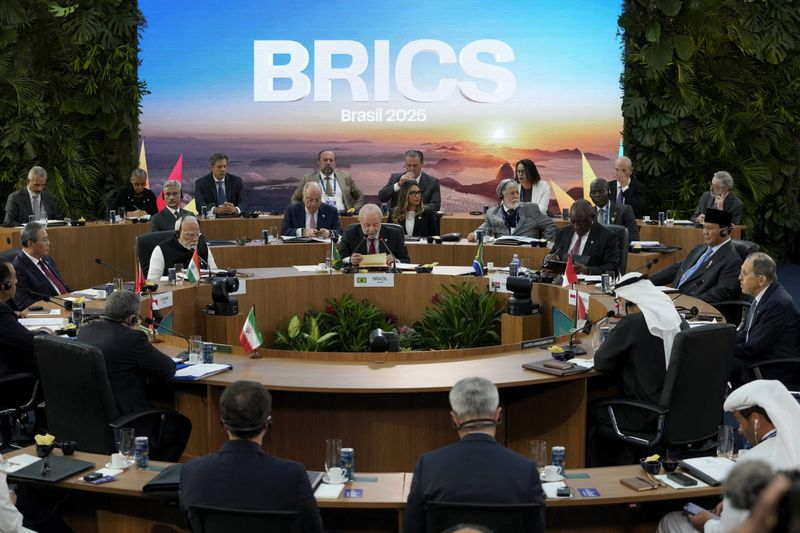
🔹 Global South vs The West: Multipolarity Hits a Wall
While BRICS continues to position itself as the “voice of the Global South,” Trump’s retaliation underscores the vulnerability of emerging economies when they confront the West in unison.
The July 6 declaration’s phrase — “rising trend of unilateralism” — was clearly aimed at Washington. But the absence of a collective economic counter-response exposed BRICS’ limits:
- No mention of cross-border payment alternatives,
- No tariff coordination or trade retaliation plan,
- No institutional mechanism for member protection.
“BRICS is aspirational, but not yet strategic,” said Kenyan economist Njeri Wanjiku. “It has weight, but not leverage.”
India in the Eye of Two Storms
India’s presence at the 17th BRICS Summit in Rio de Janeiro was no surprise. As a founding member, a long-time advocate for multipolarity, and a major regional power, New Delhi had both diplomatic obligations and strategic incentives to attend. But what began as a routine multilateral summit swiftly escalated into a test of India’s global balancing act — as US President Donald Trump’s fresh 10% tariff warning against BRICS-aligned nations disrupted the careful equilibrium India has maintained between East and West.
While Prime Minister Narendra Modi spoke forcefully against terrorism and in favor of UN reform at the BRICS gathering, his calibrated silence on Gaza, cautious language on Iran, and non-endorsement of the BRICS currency proposal revealed a nation hedging its bets in an increasingly hostile strategic environment.
India’s core dilemma? How to remain a credible leader within the Global South and BRICS, while preserving its high-value strategic and trade relationship with the United States — now in open economic confrontation with the bloc.
🔹 India’s Calculated Engagement: Why Modi Showed Up
Despite growing friction between BRICS and Washington, Prime Minister Modi’s decision to attend the Rio Summit was politically significant. His participation sent a message of continuity — India will neither abandon multilateral forums nor shy away from representing Southern voices.
According to Ministry of External Affairs (MEA) sources, India’s main goals in Rio were:
- To ensure strong anti-terrorism language, particularly referencing the April 22 Pahalgam attack,
- To reassert UNSC reform as a Global South imperative,
- To temper provocative rhetoric on Gaza, Iran, and the United States,
- To prevent overreach on BRICS currency or dollar de-pegging narratives.
A senior Indian diplomat, involved in the summit preparations, told Liberty Wire:
“We supported a robust statement on Gaza and Iran, but avoided anything that could be seen as overtly anti-West. There is no gain for India in picking a side in the emerging bifurcation of world order.”
🔹 Gaza: India’s Rhetoric vs Record
The BRICS declaration strongly condemned Israeli attacks on humanitarian operations in Gaza, and called for a permanent ceasefire, full IDF withdrawal, and immediate aid access. However, this came shortly after India abstained on a similar UNGA resolution in June.
Domestically, Modi’s presence on a declaration endorsing Gaza protections, despite abstaining at the UN, triggered political criticism.
- The Opposition Indian National Congress accused the government of “moral confusion”.
- Human rights activists called India’s abstention at the UN “a betrayal of its non-aligned legacy”.
In response, government officials noted that the BRICS text was multilateral and consensus-based, and didn’t require a national vote or legal position.
“India remains committed to humanitarian principles. However, we will not be drawn into conflicts that destabilize our diplomatic calculus,” said an MEA official.
This stance reflects India’s strategy: participate in normative solidarity, while avoiding binary alignment.
🔹 Iran and the Quiet Diplomacy of Distance
While Iran received sympathetic language in the BRICS declaration — especially the condemnation of attacks on its nuclear and civilian infrastructure — India carefully avoided overt expressions of solidarity.
Unlike Iran, which called for stronger anti-Israel language and rejected the two-state solution, India maintained its traditional line, endorsing:
- Peace through dialogue,
- Respect for international law, and
- Continued support for the two-state framework.
Privately, Indian diplomats acknowledged that Iran’s hardline statements post-summit created friction within BRICS.
“India cannot endorse radical geopolitical postures. We are not a revisionist power. We are a reformist power,” said an Indian BRICS delegation member.
This quiet but consistent moderation is what makes India both respected and indispensable — yet also vulnerable to being squeezed between ideological extremes within the bloc.
🔹 Trump’s 10% Tariff Shock: India’s Economic Pain Points
On July 6, President Donald Trump’s announcement that any BRICS-aligned country would face an additional 10% tariff caught Indian officials off guard.
The news rattled financial markets in Mumbai, with:
- The Sensex dropping 900 points in early trading,
- Export sectors such as pharma, textiles, and electronics seeing investor panic,
- The rupee hitting a five-month low against the US dollar.
India exports over $85 billion annually to the US, with key sectors including:
- Pharmaceuticals ($6.7 billion),
- Jewelry and precious metals,
- IT and software services,
- Auto parts and electronics.
A 10% blanket tariff would deepen inflationary pressures, disrupt supply chains, and damage GDP forecasts in an already uncertain post-pandemic recovery.
The Finance Ministry has reportedly prepared a contingency trade plan in consultation with industry bodies and the Confederation of Indian Industry (CII).
“We will seek diplomatic clarity from the USTR and push for India-specific exemptions,” a Commerce Ministry insider confirmed.
🔹 Strategic Hedging: Why India Opposed the BRICS Currency
One of the most telling moments of the Rio Summit was the absence of any reference to a BRICS common currency. This was widely interpreted as a setback for the de-dollarization agenda, largely championed by Russia and China.
India, it turns out, played a key role in deferring the idea.
Sources indicate that India raised the following concerns:
- Operational feasibility: Managing a new currency among economies with divergent inflation, trade and debt profiles is logistically unviable.
- Geopolitical backlash: Any formal step to replace the dollar in global trade would draw massive retaliation from the US, which India cannot afford.
- Multilateral confusion: India is also an active member of the G20, QUAD, SCO, and IPEF. Moving forward with an exclusive BRICS currency may undermine its multi-vector foreign policy.
“We are not against the idea of global financial diversification,” said a former RBI Governor. “But jumping into an anti-dollar mechanism would be strategically premature.”
India’s position reflects pragmatic realism — the currency conversation is postponed, not abandoned.
🔹 The UNSC Reform Trap: The More BRICS Grows, the Less It Agrees
India’s core diplomatic goal at BRICS has always been UN Security Council reform. While the Rio declaration referenced the “aspirations of Brazil and India,” the language was diluted by:
- African rivalries (Egypt vs South Africa vs Ethiopia),
- Reluctance from China to endorse any meaningful expansion of P5 membership,
- Absence of consensus on what “reform” actually entails.
This has left India with symbolic affirmations but no structural progress — a pattern repeated at every BRICS summit since 2011.
“We are caught in a multilateral paradox,” says former Indian Ambassador to the UN, Syed Akbaruddin. “The larger the group grows, the smaller the clarity on Security Council reform.”
Still, Indian officials stress that BRICS remains the only bloc where even rhetorical support for India’s UNSC claim is repeated every year.
🔹 Balancing Act or Tightrope Trap?
India’s foreign policy in 2025 is one of high-wire diplomacy. Its guiding doctrines — strategic autonomy, multi-alignment, issue-based coalitions — now face their severest stress test.
- The West expects India to moderate BRICS’ growing assertiveness,
- The BRICS bloc expects India to champion the South’s interests without compromise,
- Global trade flows, energy security, and defense ties all hang in the balance.
“India will not be trapped into Cold War binaries,” declared External Affairs Minister S. Jaishankar earlier this year. “We will choose interest over ideology, and capability over coercion.”
Yet, even as India repeats its mantra of autonomy over alignment, the costs of association are growing — whether it’s US tariffs, regional security threats, or institutional deadlocks in bodies like BRICS and the UN.
From WTO to BRICS – A System Stretched to Breaking Point
The global trading system, already reeling from post-pandemic supply chain shocks, energy market turbulence, and war-induced inflation, now faces an unprecedented stress test. With US President Donald Trump’s unilateral 10% tariff on all BRICS-aligned countries and warnings of further escalation, what remained of the World Trade Organization’s (WTO) credibility has entered uncharted waters.
In parallel, the BRICS Rio declaration’s strong denunciation of “unilateral tariff and non-tariff measures” and “indiscriminate protectionism” marks a shift in the bloc’s orientation: it is no longer just a forum for coordination, but a nascent resistance movement against the Western-designed trade regime.
With this trade brinkmanship unfolding across capitals, customs zones, and diplomatic forums, Liberty Wire’s fourth installment in this BRICS series examines how:
- Multilateralism is collapsing under geopolitical weight,
- Global South economies are being forced into dangerous binary choices,
- The WTO is increasingly sidelined,
- BRICS may be moving toward an alternative architecture of economic resistance.
🔹 Tariff Wars 2.0: Trump’s Protectionism Reignited
President Donald Trump’s threat to impose additional 10% tariffs on all BRICS-aligned countries, made via Truth Social on July 6, builds on his earlier 2025 policy announcement of “reciprocal tariffs”, which included:
- 26% for India,
- 30% for South Africa,
- 84% for China,
- 100% tariffs on any country backing BRICS de-dollarization proposals.
The initial tariffs were delayed for 90 days for trade negotiations. However, Trump’s July 6 declaration effectively overrules the moratorium, throwing thousands of bilateral trade deals, GSP exemptions, and investment protections into uncertainty.

“We’ve been warning about BRICS’ currency games and anti-dollar clubs. They didn’t listen. Now they pay,” Trump posted.
The White House confirmed that the tariffs will apply from July 9, and customs enforcement mechanisms are being put in place across ports and digital gateways.
This aggressive tariff policy is widely seen as a strategy to weaponize trade as a tool for:
- Disincentivizing bloc politics,
- Punishing strategic defiance,
- Restoring US economic leverage over emerging powers.
🔹 WTO on the Sidelines: Paralysis in Geneva
As BRICS leaders called the new tariffs “arbitrary and illegal,” global attention turned to the World Trade Organization (WTO) in Geneva. But WTO insiders admit they are powerless to intervene:
- The WTO appellate body has been non-functional since 2020, following US refusal to appoint judges.
- The dispute settlement process, once considered the WTO’s core strength, is now slow, toothless, and riddled with enforcement gaps.
- Most tariff disputes filed after 2022 remain unresolved.
A senior WTO official privately told Liberty Wire:
“What we are seeing is not just erosion, but collapse of WTO authority. Major economies now ignore the rules with impunity. This is institutional irrelevance, in real time.”
India and South Africa are reportedly exploring joint WTO complaints, but the political will — and enforceability — remains uncertain.
🔹 BRICS’ Anti-Tariff Message: Strong Words, Limited Teeth
The BRICS Rio declaration denounced:
- “The rise of unilateral coercive measures,”
- “Discriminatory tariff regimes that undermine global supply chains,”
- “Illegitimate extra-territorial application of domestic trade laws.”
While this language reflects growing frustration with Western economic dominance, BRICS as a bloc lacks any retaliatory trade mechanism. There is:
- No BRICS-wide tariff union,
- No internal free trade agreement,
- No collective response framework to trade aggression.
A Brazilian official put it bluntly:
“We have moral solidarity, but not yet economic instruments.”
Yet despite these limitations, the rhetorical power of BRICS’ opposition is growing — particularly among countries in Latin America, Africa, and Southeast Asia that have faced similar coercive trade measures from the West.
This rising ideological legitimacy — even without hard tools — may shape global public opinion and investor sentiment in the years ahead.
🔹 Dollar Dominance Under Debate: De-Dollarization Deferred, Not Defeated
Much of Trump’s tariff fury was originally triggered by reports in early 2025 that BRICS was planning to launch a joint currency to reduce dollar dependency. Though the currency proposal was not adopted in Rio, Washington’s reaction shows how sensitive it is to any steps toward de-dollarization.
Key developments:
- BRICS members reiterated the need for diversified global payment systems.
- Russia and China pushed for increased use of national currencies in bilateral trade.
- India and Brazil urged caution, citing inflation risks and cross-border liquidity challenges.
“No one wants to collapse the dollar overnight,” said a South African central bank official. “But a more plural system is inevitable. That’s why the US is so anxious.”
While the BRICS currency is shelved for now, many analysts believe the long-term structural shift is underway, driven by:
- US sanctions weaponization,
- SWIFT system vulnerabilities,
- Demand for financial sovereignty in the Global South.
This is slow erosion, not sudden replacement.
🔹 Supply Chains at Risk: The Real Cost of Tariff Escalation
Trump’s tariffs are not just policy statements — they are economic earthquakes. Immediate impacts expected:
- Higher input costs for BRICS exporters to the US,
- Diversion of supply chains to third countries (like Mexico, Vietnam, and Bangladesh),
- Disruption of critical sectors: pharmaceuticals (India), rare earths (China), platinum (South Africa), fertilizer (Russia/Brazil).
For example:
- India’s textile sector, already under pressure from automation and low-cost competition, could see a 35% export drop if tariffs persist.
- South African automobile exports to the US, largely under GSP, may be crippled.
- China’s electronics and green tech exports will face logistical and pricing chaos as US buyers reassess suppliers.
“This isn’t decoupling. It’s a forced divorce,” said global trade analyst Dr. Jonas Feldman. “And like any messy separation, everyone loses something.”
🔹 Rise of Parallel Institutions? The New Frontier of BRICS Economic Strategy
In response to the trade upheaval, some BRICS insiders are advocating for the rapid acceleration of alternative institutions, including:
- Expansion of the New Development Bank (NDB) beyond infrastructure to include emergency trade finance.
- Establishment of a BRICS Trade Settlement Mechanism based on local currencies.
- Creation of a South-South tariff shield: a coordinated reduction of intra-BRICS tariffs to buffer external shocks.
So far, no official commitments have been made, but the political appetite is rising.
An Ethiopian official told Liberty Wire:
“If they shut us out of their markets, we must build our own.”
Such proposals, while still embryonic, reflect a growing shift from resistance to construction — BRICS may move from being merely reactive to proactively shaping a parallel economic architecture.
🔹 Global South Watch: Watching, Waiting, Choosing
Beyond BRICS, dozens of countries are watching this realignment carefully. Nations like:
- Kenya, Malaysia, and Argentina are contemplating BRICS membership.
- Vietnam, Bangladesh, and Colombia are weighing the costs of alignment with either the US-led order or the BRICS alternative.
- Many African and Caribbean nations are increasingly vocal about the need for a post-WTO trading compact.
“We’ve seen enough of trade as a weapon,” said Kenyan Trade Minister Mwangi Kibicho. “It’s time to reimagine global trade as a commons, not a cudgel.”
The risk for Washington is that the more it punishes bloc behavior, the more it encourages it. This could create a self-fulfilling spiral of economic polarization that no institution is prepared to manage.
🔹 Multilateralism’s Existential Moment
The 2025 BRICS summit in Rio may be remembered as the moment the illusion of global trade unity shattered. While no official rupture occurred, the contradictions between the old order (WTO, G7, dollar trade) and the emerging one (BRICS+, regional blocs, multi-currency systems) are no longer manageable under a single institutional umbrella.
What lies ahead may not be a Cold War-style split — but fragmentation, redundancy, and slow attrition of global norms. Unless institutional reforms emerge fast — at the WTO, IMF, and UN — the world could soon enter a balkanized economic order, where trade is a tool of power, not prosperity.
Also REad : Akash Deep Shines at Edgbaston: The Boy from Sasaram Who Took 5 Wickets to Rattle England in Just 8 Overs


